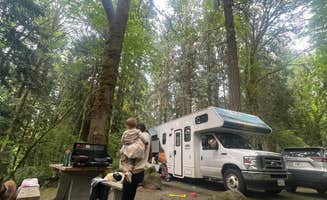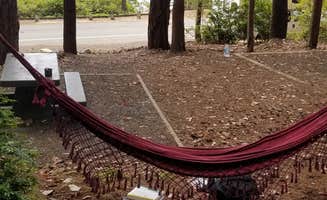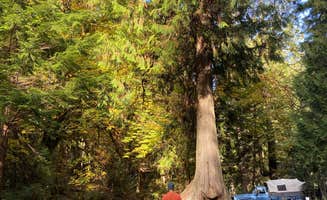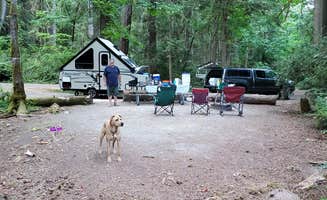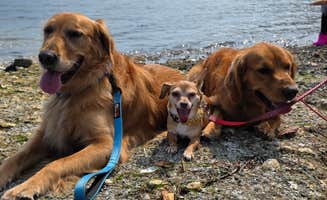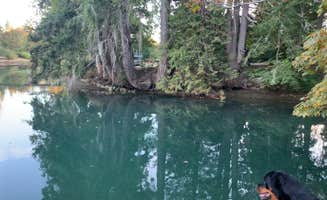Port Orchard sits on the Kitsap Peninsula where temperatures range from 70-80°F in summer to 40-50°F during winter months. The area receives around 40 inches of annual rainfall, creating lush forest environments with a mix of Douglas fir and western hemlock trees. Most campgrounds near Port Orchard maintain open sites year-round, though winter campers should prepare for muddy conditions.
What to do
Beachcombing and shellfish harvesting: Enjoy the Hood Canal shoreline at Seal Rock Campground where you can collect oysters along the beach. "We strolled down to the water and around the grounds to get the night vibe of the place and sniff the brine coming off the canal," shares Amber B. The oyster beds are accessible during low tide periods, making it ideal for shellfish gathering.
Forest hiking: Multiple trail systems connect directly to campsites at Scenic Beach State Park Campground, offering paths through dense Pacific Northwest forests. A camper notes, "There are lots of picnic tables in the area. The beach itself is covered in rocks and oyster shells. When I was there it was almost always totally empty besides myself." Trails range from easy shoreline walks to moderate forest routes.
Water activities: Take advantage of the warm, shallow waters at Belfair State Park where families can safely swim. According to one visitor, "The beach was great, water is rather warm for in the sound, it's also pretty shallow which is great for the kids to play in." Canoeing and kayaking opportunities exist throughout the Hood Canal waterways.
What campers like
Private, wooded sites: Penrose Point State Park Campground offers secluded camping spots with natural vegetation barriers. "The densely tree-lined sites provided privacy. Campsites are just a short walk from a calm cove of Puget Sound and our family had a great time playing in the water each day," reports Sarah H. Sites include fire rings and picnic tables.
Easy ferry access: Visitors appreciate Fay Bainbridge Park for its proximity to Seattle via ferry. "Quaint park. The tent spots are clustered together in 2 areas with a shared covered pavilion," explains Sable. The park's waterfront location provides views of passing cruise ships and mountains on clear days.
Wildlife viewing: Campers regularly spot bald eagles and elk at Dosewallips State Park Campground. "Every night, my husband and I would walk to the wildlife viewing platform to see lots of birds, or walk down by the river and see lots of elk and bald eagles," shares Amy & Stu B. Wildlife viewing is best during morning and evening hours.
What you should know
Reservations essential: Most campgrounds fill quickly during summer months, especially waterfront sites. At Twanoh State Park, "The beach loop fills up quickly - get your reservations in as early as possible if you want to camp there," advises Scott S. For weekend camping between May and September, book 3-6 months ahead.
Campground layouts vary: Some parks offer more privacy than others. "This campground is remarkable in the privacy between each of the camping spots, the bird life, the wild and deep forest vibes, and the walking trails," says Brittany D. about Dash Point State Park, while at Twanoh, "There is zero buffer between you and the other campers."
Water access considerations: Not all waterfront campgrounds have direct beach access from campsites. "You have to cross Rt. 106 to get to the waterside picnic area and docks, and that can get fairly busy," notes Thomas B. about Twanoh State Park. Beach access often requires short walks from camping areas.
Tips for camping with families
Playground access: Multiple parks feature children's play areas. At Dash Point State Park Campground, families appreciate the "pet friendly and dog park" plus the "day use lake" where families can swim. Fay Bainbridge offers "a pirate ship playground for children" that provides entertainment during downtime.
Spacious group sites: Families traveling together should consider group camping options. "Plenty of group tent sites as well as regular RV and tent sites. Each site comes with fire pit, hook ups, and a picnic table," says Shariah T. about Dosewallips State Park. Group sites typically accommodate 8-25 people.
Dog-friendly options: Most campgrounds welcome pets with standard leash requirements. "Pet friendly, but not many attractions for children (no playground, no pool)," notes Joseph I. about Sun Outdoors Gig Harbor. Remember to bring waste bags as enforcement of cleanup rules is consistent throughout regional parks.
Tips from RVers
Hookup availability: Sun Outdoors Gig Harbor offers full-service sites with amenities specifically designed for RVers. "Very well laid out. Beautiful trees and landscaping. Well maintained, full facilities in amenities, A1 staff - very friendly and helpful and wanting to please," reports Mike E. Sites include water, electric and sewer connections with both 30 and 50-amp service.
Site sizing considerations: RV campers should check site dimensions before booking. "Larger RVs should be in the lower site numbers. Ours is mid-size and we barely fit in #26, though it was nicely shaded," cautions Judy J. about Fay Bainbridge Park. Most state parks accommodate RVs up to 35 feet, while private resorts can handle larger rigs.
Dump station access: Not all campgrounds with RV sites have sewer hookups. James and Susan K. note that at Dosewallips State Park, "Some sites have partial hookups w/o septic. Dump station is on site." Plan accordingly for stay length based on tank capacity and dump station availability.


